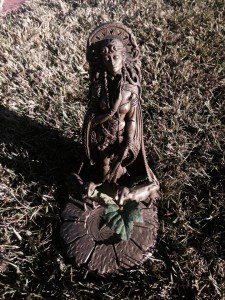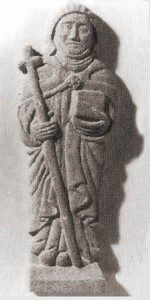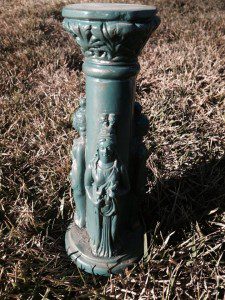The first named goddess I ever developed a relationship with was Brigid (also known as Bríg, Bríd, Brigid, Brighid, and by many other spellings). Until Brigid (often pronounced “bride” or Bridge-ett) my devotions were reserved to archetypal Mother Goddess figures; powerful but nameless beyond the epithet. Brigid changed all of that and opened up a world to me full of Pans, Shivas, and Aphrodites.

Not surprisingly I encountered Brigid fairly early on my Pagan journey. Pagan books from popular presses in the 1990’s were full of Celtic imagery, gods, goddesses, mythology, and lore. Not finding Brigid in that milieu would have been damn near impossible. She was written about as a Celtic-Isis, a near universal deity who was the goddess of just about everything. According to those books she was a goddess of fire, the forge, fertility, healing, the arts, poetry, divination, animals, inspiration, agriculture, witchcraft (!), love, learning, sacred prostitutes, and martial arts. (1) About the only thing missing or not inferred on that list is death.
Beyond the universal lists of things associated with Brigid was the fact that she was later transformed into a Christian Saint. When first encountering Paganism those types of revelations were absolutely stunning. Since I wasn’t a neophyte-Pagan recovering from a bad experience with Christianity I gravitated towards those moments when the Pagan and Christian inter-mingled. I loved the idea of someone praying to Saint Brigid not realizing it was secretly one of our goddesses! Such is Her power that the usurpers were unable to take Brigid from the folk!
 While that idea has most certainly been overly romanticized, it’s still essentially true. The origins of Saint Brigid the Irish Saint most certainly mingle with that of the Celtic Goddess Brihid. (2) There are no contemporary or near contemporary surviving records of the Irish Saint, and the legends surrounding her range from her being a contemporary of Jesus, to a nun in dying in the year 524 CE. A medieval list of Irish Saints actually lists 25 different Brigits/Bríds, all or none of whom may have been historical personages (though it’s more likely the latter). (3) It’s certainly possible that a real Brigid existed and was a Catholic nun in Ireland, but the myth and cult that grew up around the name has at least some of its origins in Celtic paganism.
While that idea has most certainly been overly romanticized, it’s still essentially true. The origins of Saint Brigid the Irish Saint most certainly mingle with that of the Celtic Goddess Brihid. (2) There are no contemporary or near contemporary surviving records of the Irish Saint, and the legends surrounding her range from her being a contemporary of Jesus, to a nun in dying in the year 524 CE. A medieval list of Irish Saints actually lists 25 different Brigits/Bríds, all or none of whom may have been historical personages (though it’s more likely the latter). (3) It’s certainly possible that a real Brigid existed and was a Catholic nun in Ireland, but the myth and cult that grew up around the name has at least some of its origins in Celtic paganism.
While it’s easy to link the deity with saint, we know very little about the goddess herself. Though she’s generally written about as a near universal-Celtic deity, there’s a great deal of debate over whether or not that was actually the case. Some scholars argue that she was a local, tutelary deity generally limited to Kildare Ireland, whose reach grew when the goddess was transformed into a Saint. There could have also been several different goddesses named Brigid (and its variations) who were mistaken for the same deity by later chroniclers. (This would be like all the different Michelles in my county being mistaken for one Michelle.) The most well known goddess of Ireland has also been linked to the Romano-British Brigantia. (4) All of these different theories may be correct, it’s also possible that none of them are. Personally I think there were many different Brigids who most likely arose from a common ancestor, but that’s just a personal theory.
 Even if her origins are lost, and her reach perhaps over-stated, there are still some things that can be said with certainty about the goddess. She was a goddess of prophesy, learning, metal working, and healing. Ronald Hutton calls her “the most pleasant Irish deity.” (5) Once one gets beyond those attributes the picture becomes a bit more fuzzy; Goddess and Saint often blend together in ways that make separating them impossible.
Even if her origins are lost, and her reach perhaps over-stated, there are still some things that can be said with certainty about the goddess. She was a goddess of prophesy, learning, metal working, and healing. Ronald Hutton calls her “the most pleasant Irish deity.” (5) Once one gets beyond those attributes the picture becomes a bit more fuzzy; Goddess and Saint often blend together in ways that make separating them impossible.
The goddess Brigid is often characterized as a fire deity, which her association with metal-working certainly implies. The word Brigid even translates as “fiery arrow” lending more credence to the argument. The most celebrated relationship Brigid had with fire was at her shrine in Kildare, which according to legend was kept first for the goddess Brigid and then later for the Saint. The first written record of the shrine its self dates back to the Seventh Century, but makes no mention of a flame being kept for the Saint. (6) That’s not to say it didn’t exist in the Seventh Century (and before!) but there’s no way of knowing for sure. The first recorded instance of Brigid’s fire at Kildare only dates to the 12th Century, though even the most conservative of scholars believe that the flame there most likely transferred form goddess to saint.
Brigid is often labeled a Triple Goddess, a term popularized by the English writer Robert Graves in his seminal work The White Goddess and used by him to describe Ireland’s most pleasant deity. When Modern Pagans use the term “Triple Goddess” it generally refers to a goddess who is (and can be worshipped as) Maiden, Mother, and Crone. This doesn’t really work for Brigid, as her myth is not one of being a Spring Maiden and a Winter Crone. Brigid was sometimes revered in triplicate, but as three sisters all bearing the same name. There was Brigid patroness of prophecy and learning, along with two sisters who shared her name, one a goddess of healing and the other a goddess of metal-work. (7) It’s possible that she was worshipped as a trio of sisters, it’s also possible that depicting her in three parts served as a way to illustrate the three talents over which she claimed dominion.
 In Modern Paganism the goddess Brigid is often associated with Imbolc, but there’s no way of knowing how ancient that pairing truly is. Certainly Saint Brigid has long been associated with the date, making it likely that the goddess was as well, but the historical record is sadly silent on the issue. In the case of Saint Brigid her association with the holiday arose due to a number of factors. Unlike her goddess predecessor, Saint Brigid was generally seen as a friend to animals and a giver of grain. Add this to the legend of her role as Jesus’s wet-nurse and it’s no surprise that she was honored in early February. The latter half of the word Imbolc has something to do with milk, and by the year 900 it was being erroneously translated as “sheep’s milk.” (8) If your Saint is a wet-nurse and a friend of domesticated animals where better to place her feast day on the Wheel of the year?
In Modern Paganism the goddess Brigid is often associated with Imbolc, but there’s no way of knowing how ancient that pairing truly is. Certainly Saint Brigid has long been associated with the date, making it likely that the goddess was as well, but the historical record is sadly silent on the issue. In the case of Saint Brigid her association with the holiday arose due to a number of factors. Unlike her goddess predecessor, Saint Brigid was generally seen as a friend to animals and a giver of grain. Add this to the legend of her role as Jesus’s wet-nurse and it’s no surprise that she was honored in early February. The latter half of the word Imbolc has something to do with milk, and by the year 900 it was being erroneously translated as “sheep’s milk.” (8) If your Saint is a wet-nurse and a friend of domesticated animals where better to place her feast day on the Wheel of the year?
Some of Imbolc’s most revered customs associated with Brigid are impossible to date back to ancient paganism. For years I took for granted that the Brigid’s Cross was a pagan survival, but the first recorded instance of one appearing over a door only dates back to the late Seventeenth Century CE. That doesn’t necessarily disqualify it as a pagan survival, it only makes the possibility less likely. I’d argue that it doesn’t matter, and that if you place one above your door, whether Pagan or Christian, someone with the name of Brigid is going to be looking out for you. (For more on the history of Imbolc, click here.)
Writing these pieces that seem to diminish a particular goddess or god often make me feel like a bearer of bad news. Personally I would much prefer Brigid to have been an unquestionable pan-Celtic European goddess of the highest order, but history paints a picture with more questions than answers. One thing I do know for certain is that as a goddess Brigid is a survivor, and one of the most continually worshipped and celebrated deities in all of ancient European paganism(s). When the conquerors and convertors came to her lands she didn’t give up the fight or go underground, she simply changed her clothing and reappeared ready to serve those who needed her. Hail Brigid (and her sisters too) unconquerable goddess!
Photos
1. Brigit by Mythic Images. Photo taken by me in my front yard.
2. Brigid statue by Maxine Miller. If you want to find it online, use the googles.
3. A depiction of Saint Brigit.
4. A Brigit column piece from JBL Statues which you can buy at Sacred Source. Yes I own a lot of statues.
References
1. At least according to D.J. Conway in Celtic Magic, the first Pagan book I ever owned. This list fascinated me in 1994, I find it a little bit dubious in 2014, though it does paint a mental image of Brigid in a mixed martial arts competition.
2. I perhaps rely on Ronald Hutton a bit too much, but Stations of the Sun (Oxford University Press 1996) is just packed with so much information that I have trouble putting it down. Most of the things written about Brihid in this piece that go back to Sun came be found on page 135.
3. Not nearly as celebrated as Sun, but one of my favorite reference works is The Pagan Religions of the British Isles Their Nature and Legacy (Blackwell Publishers 1991) also by Ronald Hutton. Yes I have kind of a fan-boy thing going on with Hutton, I won’t deny it. This citation is from page 153.
4. Stations of the Sun page 135
5. Stations of the Sun again on page 135
6. Guess what? Stations of the Sun page 135
7. Not Sun, this time Pagan Religions page 153
8. Stations of the Sun page 134
Though I didn’t reference it, my early Pagan days were influenced by the book Celtic Gods, Celtic Goddesses by R.J. Stewart (Blandford 1990).
For more on Brigid vist:
Brigit’s Forge, a most excellent resource on all things Brigit.

















